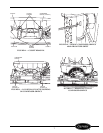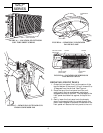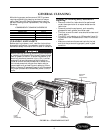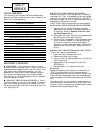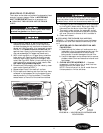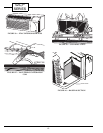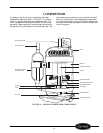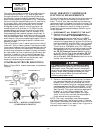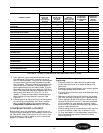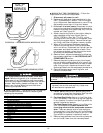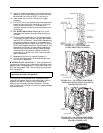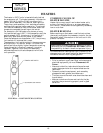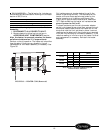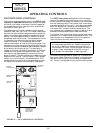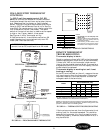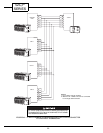
15
FIGURE 29 — BASIC COMPRESSOR TROUBLESHOOTING GUIDE
5. Next, perform a grounded windings test to test
the resistance individually of each wire to the
shell of the compressor. The paint on the compres-
sor can prevent good contact between the probe
and the metal. The paint should be removed from
a small section of the shell of the compressor to
ensure good contact by the meter probe. The volt-
ohmmeter should be set to at least the 100X ohm
level. The measured resistance between each wire
and ground should be infinite or O.L. on the
readout. If there is measurable resistance one of
the windings is likely shorted to ground. See
Figure 31.
6. A compressor that has a winding to winding short
or a winding to compressor shell short is electri-
cally failed and needs to be replaced. See the
Compressor Replacement section for details.
COMPRESSOR REPLACEMENT
Before working on the compressor, read the instruc-
tions thoroughly and gather the necessary tools for the
job. Review all safety information on unit and in liter-
ature. Always turn off all power to unit to avoid the
possibility of electrical shock.
POSSIBLE CAUSE
SYMPTOM
Compressor
Starts and
Runs But
Cycles On the
Overload
Compressor
Starts After
Cycling the
Overload
Several Times
Compressor
Will Not
Start. It Hums
and Cycles On
the Overload
Compressor
Will Not Start
and Makes No
Noise
Compressor
Cycles Off
(Not On
Overload)
COILS/FILTERS DIRTY OR PLUGGED
X
AIR OR NONCONDENSABLE GASES
IN SYSTEM
XX
SYSTEM REFRIGERANT OVERCHARGED
X X
DISCHARGE LINE RESTRICTED
XX
CAPILLARY TUBE OR STRAINER
RESTRICTED OR PLUGGED
XX X
FAN BLADE OR MOTOR DEFECTIVE
X X
FAN BLADE OR BLOWER WHEEL STUCK
X X
SYSTEM REFRIGERANT UNDERCHARGED
X X
EVAPORATOR AIRFLOW RECIRCULATION
X
UNIT OVERSIZED FOR APPLICATION
X
COMPRESSOR REQUIRES START ASSIST
XX
NO POWER TO UNIT
X
LOW VOLTAGE TO UNIT
XXX X
OVERLOAD PROTECTOR OPEN
X
OVERLOAD PROTECTOR INCORRECT
OR DEFECTIVE
XXX
CAPACITOR INCORRECT OR DEFECTIVE
XXX X
THERMOSTAT CONTACTS ARE OPEN
X
THERMOSTAT IS SET TOO HIGH OR LOW
X
SELECTOR SWITCH IS OPEN
OR DEFECTIVE
X
WIRING IS INCORRECT OR DEFECTIVE
XXXX
SYSTEM PRESSURES NOT EQUALIZED
XX X
COMPRESSOR MOTOR OR
MECHANISM DEFECTIVE
XXX XX
COMPRESSOR GROUNDED
X
Consider the following safety issues before
beginning:
• New and unfamiliar tasks should be performed
under the supervision of an experienced service
technician.
• Personal protective equipment, such as work gloves
and safety glasses, should be worn.
• The floor around the work area should be clean and
free of debris.
• Make sure tools are the correct tools for the job and
that they are working properly and in good condition.
• Never replace a blown fuse without correcting the
cause of the original failure. If thermally operated
circuit breakers or overloads are tripping, make
sure the trip is not due to excessively high tempera-
tures or loose connections.
• When brazing suction and discharge lines, cool the
lines with a damp, clean cloth to prevent injury.
• Oil may be present in the compressor accumulator
and interconnecting tubing. Use caution when
removing tubing.



